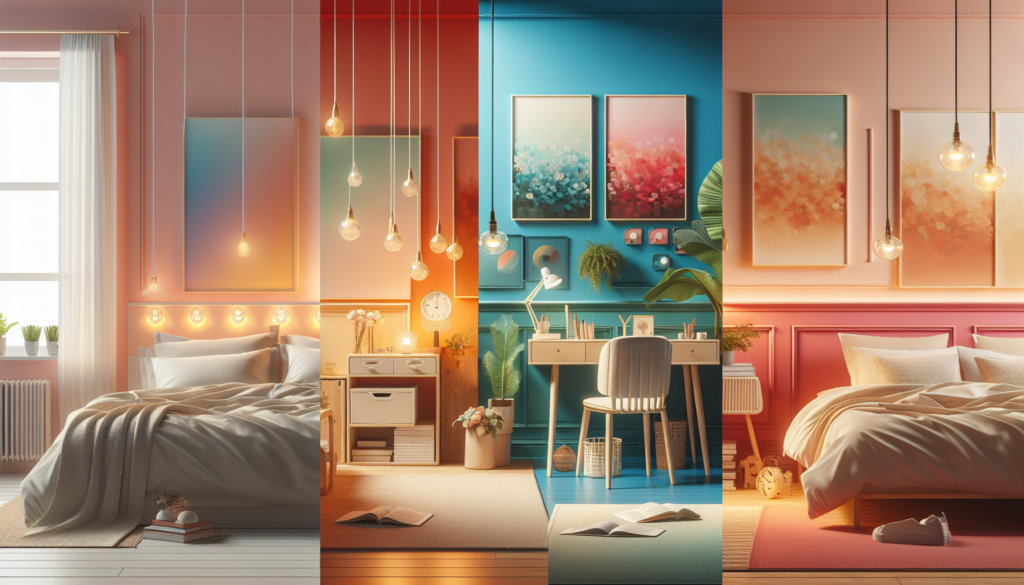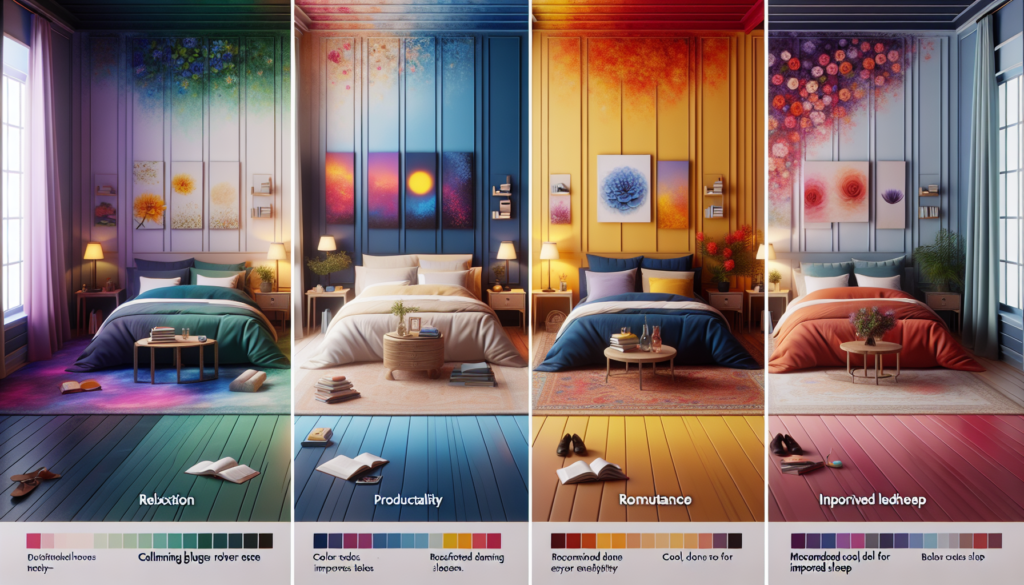
If you’re looking to create a harmonious and relaxing atmosphere in your bedroom, understanding color psychology can be a valuable tool. By carefully selecting and incorporating specific colors into your bedroom design, you can influence the mood and emotions within the space. From soothing blues to stimulating yellows, each color has the power to evoke different feelings and set the tone for a restful or energizing environment. In this article, we’ll explore how you can effectively use color psychology to transform your bedroom into a serene sanctuary or a vibrant retreat. Whether you’re aiming for a calming oasis or a lively haven, discovering the impact of color on your bedroom’s ambience can help you create the perfect setting for rest, relaxation, and rejuvenation.

Understanding Color Psychology
Colors have a significant impact on our emotions and psychology, and this is especially true when it comes to designing our bedrooms. The colors we choose for our bedroom space can have a profound effect on our mood, relaxation, and overall well-being. By understanding the principles of color psychology, we can create a bedroom environment that promotes restful sleep, relaxation, and personal style.
The Impact of Colors on Our Psychology
Colors have the power to evoke a wide range of emotions and psychological responses. For example, blues and greens are often associated with feelings of calmness and tranquility, while warm colors like reds and oranges can create a sense of energy and vibrancy. Understanding these associations can help us choose colors that align with the intended mood and atmosphere of our bedroom.
The Role of Color in Interior Design
Color plays a crucial role in interior design as it sets the tone and atmosphere of a space. In the context of a bedroom, the right color palette can create a serene and inviting environment, making it a sanctuary for relaxation and rejuvenation. By considering the purpose of the room, the lighting, and personal preferences, we can create a color scheme that enhances the overall design and function of the bedroom.
Choosing the Right Color Palette
When choosing a color palette for your bedroom, it is essential to take several factors into consideration.
Consider the Bedroom’s Purpose
First and foremost, think about the purpose of your bedroom. Is it a space solely for sleeping and relaxation, or do you use it for other activities like reading or working? Different activities may require different color choices. For a calm and serene atmosphere, consider soothing and neutral colors. If you want to create a more energetic and vibrant space, bolder colors may be appropriate.
Evaluate the Room’s Lighting
Lighting plays a crucial role in how colors appear in a room. Consider the natural light sources and the type of artificial lighting in your bedroom. Rooms with ample natural light can handle bolder colors, while dimly lit rooms may benefit from lighter shades to create an illusion of brightness.
Personal Preferences and Associations
Lastly, consider your personal preferences and associations with certain colors. What colors make you feel relaxed and at ease? What colors bring you joy and make you feel happy? By aligning your color choices with your personal preferences, you can create a bedroom that feels uniquely yours.

Calming Bedroom Colors
If you are looking to create a tranquil and calming atmosphere in your bedroom, consider incorporating these colors:
Tranquil Blues
Blue is often associated with serenity and calmness. Light shades of blue, like sky blue or powder blue, can create a soothing and peaceful environment in your bedroom. These shades are known to lower blood pressure and promote relaxation, making them an excellent choice for bedrooms.
Soothing Greens
Green is another color that promotes a sense of tranquility and relaxation. Shades of green, such as sage green or mint green, can create a peaceful and harmonious atmosphere in your bedroom. Green is also known to have a calming effect on the eyes, making it an ideal color for a restful sleep environment.
Peaceful Lavenders
Lavender is a color often associated with relaxation and restfulness. Its soft and subtle tones can create a calming and serene atmosphere in your bedroom. Lavender promotes a sense of tranquility and can help reduce stress and anxiety, making it an excellent choice for those seeking a peaceful sleep environment.
Energizing Bedroom Colors
If you want to infuse energy and vibrancy into your bedroom, consider incorporating these colors:
Vibrant Reds
Red is a color known for its energizing and stimulating qualities. It can evoke feelings of passion, excitement, and vitality. While red may not be suitable for the entire bedroom, incorporating it as an accent color can create a visually striking and energizing effect.
Energetic Oranges
Orange is a warm and energetic color that can bring a sense of enthusiasm and creativity to your bedroom. It is often associated with warmth and vitality, making it a great choice for those who want to create an energetic and vibrant space.
Invigorating Yellows
Yellow is a color that promotes positivity, happiness, and optimism. It can create a lively and invigorating atmosphere in your bedroom. However, it is essential to use yellow in moderation, as too much of it can be overwhelming and create feelings of anxiety.

Creating a Relaxing Atmosphere
To create a truly relaxing atmosphere in your bedroom, consider the following tips:
Using Neutrals for a Serene Base
Start by using neutral colors as a base for your bedroom walls and larger furniture pieces. Shades of white, beige, or gray can create a serene and calming backdrop that allows other colors to stand out.
Layering Colors for Depth
Add depth to your bedroom by incorporating different shades and tones of the chosen color palette. By layering colors, you can create a visually interesting and harmonious space that promotes relaxation.
Incorporating Natural Elements
Bringing elements of nature into your bedroom can enhance its calming atmosphere. Consider adding potted plants, wooden furniture, or natural textiles to create a sense of tranquility and connection with the outdoors.
Promoting Restful Sleep
To promote restful sleep, it is important to choose colors that create a calming and soothing environment in your bedroom.
Opting for Cool Tones
Cool tones, such as blues and greens, are known to have a calming effect on the mind and body. These colors can help lower heart rate and blood pressure, creating an ideal environment for restful sleep.
Avoiding Stimulating Colors
While vibrant and energetic colors have their place in the bedroom, it is best to avoid using them in large quantities near the sleeping area. These colors can be overly stimulating and make it difficult to relax and unwind before sleep.
Creating a Dark and Cozy Environment
If you prefer a darker environment to sleep in, consider using deep, rich colors like navy blue or charcoal gray. These colors can create a cocoon-like atmosphere that promotes a sense of safety and intimacy.

Adding Personality and Style
Injecting your personality and style into your bedroom can be achieved through thoughtful color choices.
Injecting Vibrant Accents
incorporate pops of vibrant colors through accessories and accent pieces. This allows you to infuse your personal style into the space while keeping the overall atmosphere calming and relaxing.
Combining Complementary Colors
Experiment with combining complementary colors to create visual interest and a unique look. By using colors that are opposite each other on the color wheel, you can create a dynamic and well-balanced color scheme.
Using Color Psychology in Accessories
Utilize color psychology principles in selecting accessories such as pillows, curtains, or artwork. For example, if you want to promote relaxation, choose accessories in calming blues or greens.
Considering Room Size and Layout
The size and layout of your bedroom can also influence color choices.
Expanding Small Bedrooms with Light Colors
If you have a small bedroom, using light colors can make it appear more spacious and open. Whites, pastels, and other light hues reflect light, creating an illusion of a larger space.
Creating Intimacy with Dark Colors
On the other hand, if you have a large bedroom or want to create a cozy, intimate atmosphere, dark colors can be used to visually bring in the walls and create a more intimate space.
Playing with Optical Illusions
colors can also be used strategically to manipulate the perception of space. For example, using a lighter color on one wall can make it appear closer, while a darker color on another wall can create the illusion of depth.

Addressing Color Preferences of Occupants
When designing a bedroom, it is essential to take into account the color preferences of those who will be using the space.
Collaborating with Homeowners
If the bedroom is for yourself or another adult, collaborate with them to understand their color preferences and how they want the space to feel. By involving homeowners in the design process, you can create a space that truly reflects their personalities and promotes relaxation.
Designing for Children’s Bedrooms
When designing children’s bedrooms, it is important to consider their age, preferences, and interests. Young children may be drawn to bright and vibrant colors, while older children may have specific preferences based on their personalities and hobbies.
Creating Gender-Neutral Spaces
For shared bedrooms or spaces that need to cater to multiple occupants, consider creating gender-neutral color schemes. Opt for neutral colors or colors that don’t conform to traditional gender stereotypes to ensure the space is inclusive and welcoming to all.
Avoiding Common Color Mistakes
While color can enhance a bedroom’s design, it is crucial to avoid common color mistakes that can negatively impact the overall atmosphere.
Using Aggressive Colors Sparingly
Colors like reds or intense yellows can be overwhelming if used excessively. Instead, incorporate them as accents or in small doses to provide a splash of energy without overpowering the space.
Respecting Cultural Color Associations
Be mindful of cultural color associations when designing your bedroom. Different colors carry various meanings and symbolism in different cultures. Research and respect these associations to ensure your color choices are appropriate and respectful.
Avoiding Overwhelming Color Schemes
too many colors or conflicting color schemes can create visual chaos and disrupt the calm atmosphere of a bedroom. Stick to a cohesive color palette and limit the number of colors used to maintain a harmonious and relaxing space.
By understanding the principles of color psychology and considering factors such as the purpose of the room, lighting, personal preferences, and occupants’ needs, we can create a bedroom that not only reflects our style but also promotes relaxation, rejuvenation, and restful sleep. So go ahead, explore the world of colors, and transform your bedroom into a sanctuary of tranquility and personal expression.
